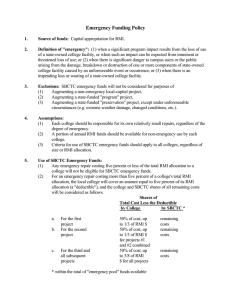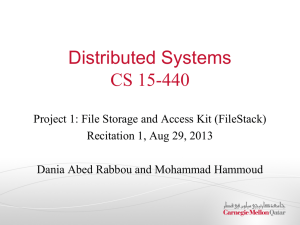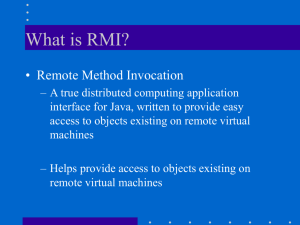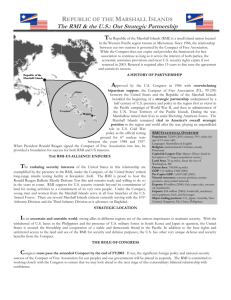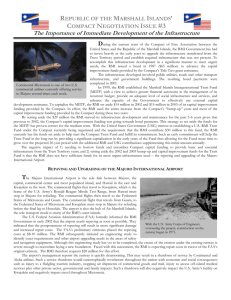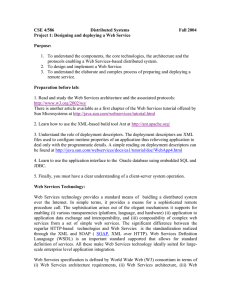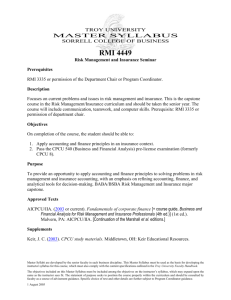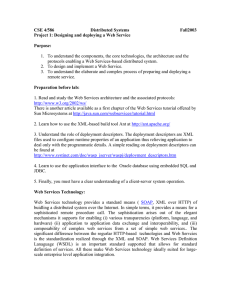Guidelines for RMI Capital Projects
advertisement
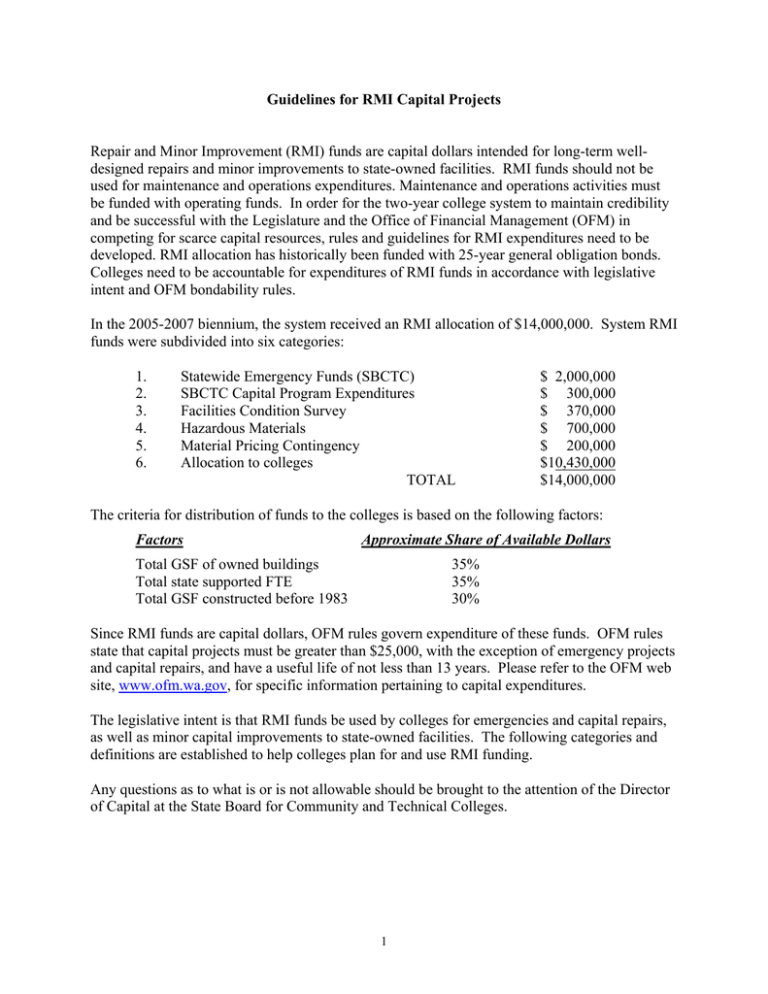
Guidelines for RMI Capital Projects Repair and Minor Improvement (RMI) funds are capital dollars intended for long-term welldesigned repairs and minor improvements to state-owned facilities. RMI funds should not be used for maintenance and operations expenditures. Maintenance and operations activities must be funded with operating funds. In order for the two-year college system to maintain credibility and be successful with the Legislature and the Office of Financial Management (OFM) in competing for scarce capital resources, rules and guidelines for RMI expenditures need to be developed. RMI allocation has historically been funded with 25-year general obligation bonds. Colleges need to be accountable for expenditures of RMI funds in accordance with legislative intent and OFM bondability rules. In the 2005-2007 biennium, the system received an RMI allocation of $14,000,000. System RMI funds were subdivided into six categories: 1. 2. 3. 4. 5. 6. Statewide Emergency Funds (SBCTC) SBCTC Capital Program Expenditures Facilities Condition Survey Hazardous Materials Material Pricing Contingency Allocation to colleges TOTAL $ 2,000,000 $ 300,000 $ 370,000 $ 700,000 $ 200,000 $10,430,000 $14,000,000 The criteria for distribution of funds to the colleges is based on the following factors: Factors Approximate Share of Available Dollars Total GSF of owned buildings Total state supported FTE Total GSF constructed before 1983 35% 35% 30% Since RMI funds are capital dollars, OFM rules govern expenditure of these funds. OFM rules state that capital projects must be greater than $25,000, with the exception of emergency projects and capital repairs, and have a useful life of not less than 13 years. Please refer to the OFM web site, www.ofm.wa.gov, for specific information pertaining to capital expenditures. The legislative intent is that RMI funds be used by colleges for emergencies and capital repairs, as well as minor capital improvements to state-owned facilities. The following categories and definitions are established to help colleges plan for and use RMI funding. Any questions as to what is or is not allowable should be brought to the attention of the Director of Capital at the State Board for Community and Technical Colleges. 1 Allowable RMI Expenditures: 1. 2. 3. 4. 5. 6. Emergency reserve Capital preservation projects Code/regulatory compliance Minor improvements Emergent/deferred capital repairs Supplemental funding for capital repair or minor improvement projects 1) Emergency Reserve Each college shall maintain an RMI fund balance for unforeseen capital repairs, critical facilities emergencies, and catastrophic losses. During the first year of the biennium, each college should try to reserve no less than 30 percent of their RMI allocation. The emergency reserve should decline to no less than 10 percent during the second year of the biennium. For large-scale emergencies, colleges may request assistance from the SBCTC Emergency Reserve Fund subject to the latest “Guidelines for SBCTC Facilities Emergency Funds”. Capital emergency repairs can be less than $25,000. (See Appendix A – Attachment One) 2) Capital Preservation Capital preservation projects include facilities repairs and minor improvements that preserve, restore, or extend the useful life of the facilities or facilities system. Priority should be given to preserving roofs and the integrity of the building envelope (e.g., damp-proofing, waterproofing, and sealants). 3) Code/Regulatory Compliance RMI funds may be used for permanent improvements to facilities to comply with codes and regulations. These improvements include seismic, fire, health, life safety, ADA and hazardous material removal (e.g., lead, PCBs, asbestos). Prior to expending RMI dollars in this category, colleges shall attempt to obtain funding from the dedicated OFM pool accounts. 4) Minor Improvements Long-term well-designed minor improvements to facilities that enhance or expand services and programs and have a minimum useful life of 13 years can be funded with RMI dollars. 5) Emergent/Deferred Capital Repairs RMI can be used to fund critical capital repairs that have emerged since the last facilities condition survey. In addition, RMI can be used to reduce repair backlogs from the Repairs “B” list. 2 6) Supplement Under-Funded Capital Projects RMI may be used to augment under-funded capital projects (e.g., minor, renovation, replacement). The RMI fund is not expected to be used routinely or wholly to augment other capital projects. Unallowable RMI Expenditures: 1. 2. 3. 4. 5. 6. 7. 8. 9. 10. Maintenance & Operations Enterprise Operations Salaries and Benefits Instructional Equipment Equipment/Furnishings Leased Facilities Parking Student Government Energy Conservation Telecommunications/Information Technology 1) Maintenance & Operations RMI funds shall not be used for preventive, predictive, or corrective maintenance or for normal operations such as grounds, security, and custodial. Normal maintenance and operating functions are to be supported by operating funds. In addition, RMI cannot be used to pay Local Improvement District assessments or in-lieu of assessments by local fire, water and sewer, and other local districts. 2) Enterprise Operations RMI funds shall not be used to support enterprise operations such as bookstores, food services, dormitory operations, or parking. Capital funds shall not be used to repair, remodel, renovate, or construct space for self-supporting enterprise operations. 3) Salaries and Benefits RMI shall not be used for salaries, benefits, or other personnel related expenses. The one exception is direct labor costs associated with a capital project. For example, if a college hires a temporary employee, or uses their own classified staff to perform an in-house allowable RMI project, then the direct labor cost may be charged to the RMI project. 4) Instructional Equipment RMI funds shall not be used for the purchase or repair of instructional equipment. The use of capital funds to purchase instructional equipment is allowable only on large capital construction projects (e.g., major, renovation, or replacement) where new space must be furnished for the first time. After the initial capital project is completed, instructional equipment is viewed as portable equipment that would be removed if the space were vacated. 3 5) Equipment/Furnishings RMI funds shall not be used to purchase or repair equipment and furnishings, including mobile equipment, tools, furniture, site furnishings, office machines, or window coverings. The use of capital funds to purchase equipment/furnishings is permissible only on a large capital project where new space is furnished for the first time. 6) Leased Facilities RMI funds shall not be used for nonstate-owned facilities. The use of RMI funds to support, repair, or remodel operating budget leased facilities (standard rental facility) is strictly prohibited. Capital lease of a facility where the state has or will obtain ownership of the property through an existing COP or lease/purchase agreement is an exception. 7) Parking RMI funds shall not be used to construct, maintain, or repair parking facilities, including parking lots, parking structures, and all appurtenances such as curbs, drainage structures, access roads, and signage. Funding for parking facilities should be derived from parking fees. Site lighting in a parking area can be improved using RMI since it is deemed a critical safety issue (emergency) with regard to students, faculty and staff. 8) Student Government RMI funds shall not be used to construct, remodel, or renovate facilities used solely for student governance, student recreation, student leisure activities, and student club rooms. Student S&A fees and ASB capital accounts shall be used for capital improvements to facilities used predominantly for the purposes stated above. Colleges are encouraged to use alternative funding (e.g., COP) to obtain capital funds for these endeavors. 9) Energy Conservation RMI funds shall not be used to pay debt service on energy conservation projects. Colleges are to use operating dollars (utility savings) to fund energy projects. The General Administration Energy Office works with state agencies and colleges to provide access to and support for evaluation and development of successful energy conservation projects. Utility assistance programs, Guaranteed Energy Savings Program, together with college utility savings can be used to finance Energy Service Company (ESCO) projects. Paybacks for reasonably developed projects are generally less than eight years. 10) Telecommunication/Information Technology RMI funds shall not be used to purchase or repair telecommunications, computing, and information technology equipment, or purchase software. RMI funds may be used to extend communication and data infrastructure (e.g., conduit and wiring). Improvements to telecommunications, computing, and technology hardware and software must be funded from operating budgets and/or student fees. 4
